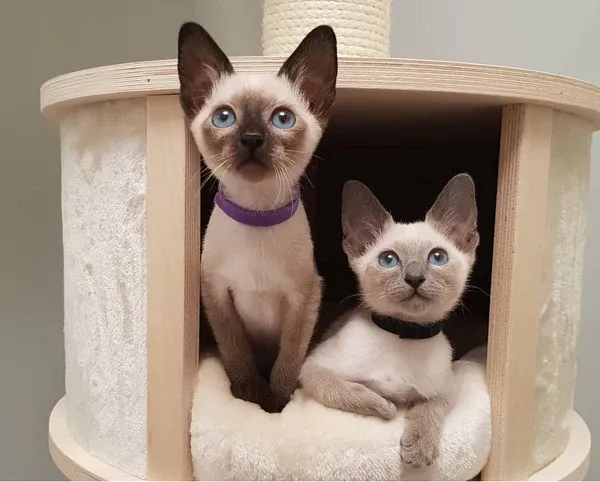Modern Siamese Cats captivate pet lovers with their sleek, elegant bodies, striking blue eyes, and vocal personalities. If you’re considering short haired cat breeds like these, understanding their unique traits is essential for providing proper care. Originating from Thailand, these cats evolved into distinct traditional and modern varieties, each with specific needs in diet, health, and grooming. This guide explores the history, differences, subtypes, and expert tips on raising a healthy modern Siamese cat, drawing from veterinary insights and real-world experiences.
Origins of the Modern Siamese Cat
The modern Siamese cat emerged in the 1960s as breeders refined the breed for cat shows. Popularity surged, leading judges and breeders to favor a slimmer, more elongated physique over the rounder traditional form. By selectively breeding for longer bodies, narrower heads, and tubular torsos, they achieved the dramatic look we see today.
This shift prioritized aesthetics, but it came at a cost. Inbreeding to exaggerate features reduced lifespans compared to traditional Siamese, increasing risks for conditions like kidney issues and urinary tract infections (UTIs). According to the Cat Fanciers’ Association (CFA), modern Siamese typically live 10-15 years, shorter than their applehead counterparts. Despite this, their allure persists, blending ancient Siamese roots with contemporary style.
 Close-up of a modern Siamese cat with blue eyes and pointed ears posing playfully
Close-up of a modern Siamese cat with blue eyes and pointed ears posing playfully
Traditional vs. Modern Siamese Cats: Key Differences
Both traditional and modern Siamese share a “pointed” color pattern—darker extremities on lighter bodies—in shades like seal, chocolate, blue, and lilac, as recognized by the CFA. They’re friendly, intelligent, affectionate, and highly vocal, making them ideal for interactive households. These traits stem from their Siamese heritage, where they thrive on attention and can even be trained for tricks.
However, physical distinctions set them apart:
| Body Feature | Traditional Siamese | Modern Siamese |
|---|---|---|
| Torso | Long, athletic | Elongated, tubular, muscular |
| Face | Round, apple-shaped | Wedge-shaped, triangular |
| Muzzle | Short, natural | Long and pointed |
| Ears | Large, pointed | Huge, forward-leaning |
| Tail | Long | Longer, thinner |
Modern Siamese are more prone to health issues due to extreme breeding, including heart problems and kidney failure. Veterinary experts recommend regular check-ups and a protein-rich diet to mitigate these risks. For a broader overview, explore all kinds of cats.
Subtypes of Modern Siamese Cats
Modern Siamese fall into three main groups: wedgehead, light-colored, and dark-colored.
Wedgehead Siamese
These feature the most extreme wedge-shaped heads, sharp faces, and slanted eyes. They’re the most vocal subtype, often “talking” to owners throughout the day. Their dramatic appearance makes them stand out in shows.
 Modern wedgehead Siamese cat with large ears and expectant expression
Modern wedgehead Siamese cat with large ears and expectant expression
Light-Colored Siamese
- Chocolate Point: Light cream body with milk-chocolate points.
- Lilac Point: Pale body with soft gray-pink points, highly sought after.
- Cream Point: Subtle light spotting, elegant and understated.
Dark-Colored Siamese
- Blue Point: Gray-blue points with captivating blue eyes; rare and prized.
- Seal Point: Darkest variant, seal-brown points contrasting vivid eyes.
- Red Point: Fiery red or orange points paired with blue eyes for an exotic look.
Compared to breeds like the colorpoint ragdoll, modern Siamese have shorter coats requiring less grooming but more dental attention.
Essential Care for Modern Siamese Cats
Modern Siamese demand attentive care due to their active nature and health predispositions. Focus on exercise, grooming, and a balanced diet tailored to their high-energy metabolism.
Optimal Nutrition
Cats are obligate carnivores, needing animal-based proteins as their primary energy source. Key nutrients include:
- Animal Protein: High biological value sources like chicken, tuna, salmon (92-99% digestibility) provide taurine for vision, heart health, reproduction, and coat quality. Avoid low-value vegetable proteins (under 65%), as cats digest them poorly.
- Animal Fats: Support cell structure and healing; limit to 20% to prevent obesity, diabetes, or arthritis.
- Water: Wet food (70% moisture) ensures hydration, outperforming dry kibble. Soak dry food in broth if mixing.
Veterinarians from the World Small Animal Veterinary Association (WSAVA) emphasize high-protein, grain-free diets. Feed based on life stage: kittens need frequent meals, seniors lower calories.
 Group of modern Siamese cats waiting for grooming or feeding
Group of modern Siamese cats waiting for grooming or feeding
Provide environmental enrichment—toys, scratching posts—and annual vet visits for dental cleanings and screenings.
Health Monitoring
Watch for signs of UTIs (frequent urination), kidney strain, or hyperactivity. Spay/neuter early to curb attention-seeking behaviors.
Conclusion: Thriving with Your Modern Siamese
Raising a modern Siamese cat offers companionship like no other, but success hinges on understanding their breeding history, subtype specifics, and nutritional demands. Prioritize vet-approved diets rich in animal proteins, regular exercise, and proactive health care to maximize their lifespan and vitality. Consult your veterinarian for personalized advice, and enjoy the vocal, loving bond with your sleek feline friend.
References:
- Cat Fanciers’ Association (CFA): Breed Standards.
- WSAVA Global Nutrition Guidelines.
- Veterinary insights from Pixabay and breed-specific studies.
